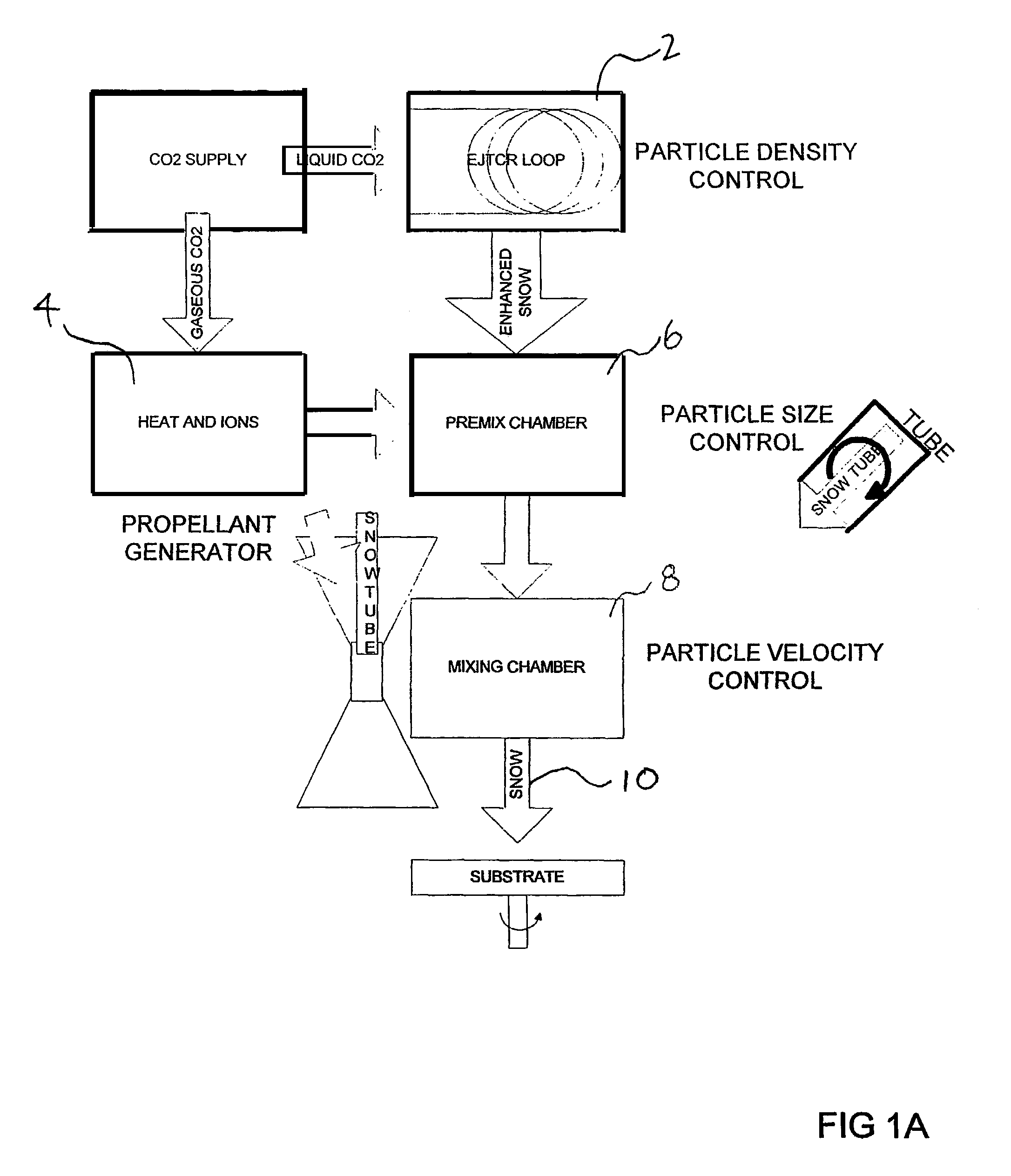[0057]There have been many patents issued, and in this decade particularly, for solid-phase cleaning devices and processes. None employ a coaxial
momentum transfer mechanism using thermal-propulsion control of
particle velocity and size described herein. Improved coaxial dense fluid spray cleaning processes and apparatuses have been developed and are described herein which greatly improve cleaning performance, operational characteristics, adaptability and versatility over U.S. Pat. No. 5,725,154 by the present. Most importantly, the present invention significantly improves the performance of conversion of
liquid phase C02 to solid phase and control of particle size and velocity.
[0059]The present invention changes
temperature and pressure of an
inert optionally, ionizable
propellant gas over a wide range of temperatures from 70 F to 300 F and pressures from 30 psi to 10,000 psi—this changes the physicochemical and kinetic characteristics of an enhanced snow
particle mass generated within a condensor tube located at the center of a coaxial
delivery system. Particle size, density, apparent
hardness and velocity of a
stream of condensed carbon dioxide can be precisely controlled by altering the
temperature and pressure of the propellant in combination with altering the length of enhanced condensation tube which supercools and condenses precisely injected amounts of
liquid carbon dioxide. An enhanced
solid particle-gas mixture is produced prior to combining with condensation tube and propellant gas tube assemblies within a coaxial delivery line. A device called an Enhanced
Joule-Thompson Condensation Reactor (EJTCR), containing a coiled or looped
reaction tube having various lengths and diameters, is used to produce and densify a mixture of
solid carbon dioxide particles (Enhanced
Snow) from a source of purified
liquid carbon dioxide. The EJTCR loop is thermally insulated and grounded and is comprised of various lengths and inside diameters of polyetheretherketone (PEEK) tubing. Because most of the condensation and sublimation
heat transfer occurs within the EJTCR loop, the result is improved efficiency of the initial
condensation reaction process. A propellant stream comprising pressurized, heated,
inert and optionally ionized gas is produced in a separate subsystem. Purified
inert gases such as carbon dioxide (preferred),
nitrogen and clean dry air are heated using an in-line heater, filtered and ionized using an in-line DC ionizer
assembly.
[0061]The efficiency, in relation to snow
mass generated and cleaning energy performed, of the present invention is increased substantially over conventional Type I snow cleaning designs. Moreover, the present invention produces
excess heat remaining following transfer, mixing and spraying operations, in accordance with the Carnot equation, which provides simultaneous local environmental control through inerting and thermostatting phenomenon.
[0063]The present invention further teaches a method of adding liquid and
gas phase additives an enhanced condensation tube which are mixed and dispersed within the dense solid phase prior to injection and mixing within a
nozzle. This provides improved physicochemical characteristics of the resulting spray cleaning agent such as improved contaminant solvency and lower tribocharging upon contact with a substrate.
[0071]Another aspect the present invention is the addition of solid abrasives to the propellant
gas supply. Mixing solid abrasives with the dense snow
mass provides an improved microabrasive finishing of substrates—cryogenic microabrasive finishing. The snow spray embrittles surface features such as burrs during simultaneous impingement of
abrasive snow additives. The surface features of the substrate become harder at a lower temperature than the subsurface—therefore
surface finishing is aided through an increase in
hardness (less rolling and
rounding of edges and burrs). Following this the spray is used to remove residue dusts and residues from the finished substrate.
[0072]Finally, the present invention discloses a cleaning
system and
system software for utilizing the various examples described above in a closed
workcell using a centralized multi-axis programmable
robot operating in a circular
workcell pattern and using various stations having increasing particle cleanliness. This embodiment teaches the use of various
robot hand tools—pick and place tool in combination with a cleaning tool, cleaning-
laser tool, cleaning-inspection tool, or cleaning-
ionization tool. Substrates are first picked up using a pick and place tool and moved from a dirty loading zone into a cleaner
process zone. The
robot then changes hand tools, placing the
hand tool in a cleaning fixture for subsequent cleaning, and picks up any one of several novel snow or snow-process robots tools. Following robotic cleaning and / or
processing, the robot cleans the pick and place tools critical surfaces, and replaces the cleaning tool with the newly cleaned pick and place tool. The cleaned substrate is picked up and placed in a still cleaner unload zone. The combination of a zoned
workcell with a programmable robot,
software and novel cleaning and cleaning-production tools provides an economical, versatile and adaptable cleaning and production tool.
 Login to View More
Login to View More 


